
Tidal Heating | ScienceLog #2
Oct 15th

Simulation in which the Moon orbits way too close to the Earth. Tidal forces from the Earth’s gravity rip fragments from the Moon, tearing it apart.
New and Improved Tidal Heating
Our first ScienceLog explained how the flow of energy into and out of an object is responsible for heating or cooling the object. If you look at the sources of energy in a simulation, listed in the Energy Flow section of the object’s Surface tab, you’ll see Tidal Power listed. Unlike some of the other heat sources, like stars or impacts, tidal heating originates inside the object itself.
Tidal heating has been a part of Universe Sandbox for some time, but after the release of our new Surface Grids feature in Update 24, we noticed that tidal heating wasn’t changing the temperature of planets the way we expected. We traced this unusual behavior back to some errors in our tidal heating calculations, and then we fixed those bugs while we prepared the energy flow tools for Update 25.
Now that we’re more confident in our tidal heating simulation, we thought that for this ScienceLog, we’d dive a little deeper into tidal heating, where it comes from, and how it works in Universe Sandbox. It may not be as flashy as other heating sources, like supernovas or lasers, but tidal heating can create some unexpected and interesting effects, and even determine the habitability of a planet or moon!
What is Tidal Heating?
As usual, it all comes back to gravity. The force of gravity depends on the distance between objects. For example, the strength of Earth’s gravitational pull on the Moon is stronger on the side of the Moon that’s facing the Earth than on the far side of the Moon. This difference, called the tidal force, can stretch the Moon out of its normally spherical shape. If the tidal forces are strong enough, they can even rip an object apart through a process called Roche fragmentation.

Jupiter’s moon Io orbiting the gas giant in a simulation with just Jupiter and its moons. Io’s eccentric orbit creates tidal friction inside the moon, and the graph of Tidal Power on the left shows how the incoming rate of tidal energy changed over time. In real life, astronomers believe this tidal heating is the source of energy for Io’s many volcanoes.
Smaller tidal forces will leave the object intact, and the “squishing” of the object’s spherical shape is usually too small to see. But if the tidal forces change over time— say, because the object is spinning, or its orbit is non-circular (elliptical)— all this squishing and un-squishing will create friction inside the object, which will add heat energy.
How Does Tidal Heating Work in Universe Sandbox?
As the simulation runs, Universe Sandbox is constantly calculating the gravitational forces pulling on every object. We use these calculations to determine where each object will move next, and how fast, but we can also use them to calculate the strength of the tidal forces inside the object. If these forces are strong enough, the simulation produces fragments to simulate Roche fragmentation tearing the object apart. It also calculates how much heating is produced by tidal friction, and sends that information into the energy flow calculations that control the object’s temperature.
With the improvements in Update 25, we’re now much more confident in our tidal heating model. We even made a new simulation to show it off: A Tidally Heated Habitable Moon. This sim demonstrates a scenario predicted by some astronomers: a moon orbiting a gas giant outside of its star’s habitable zone. Normally this distance would make the moon’s surface too cold to support liquid water, but tidal forces from the gas giant heat the moon’s surface to a balmy, habitable 14.9°C.
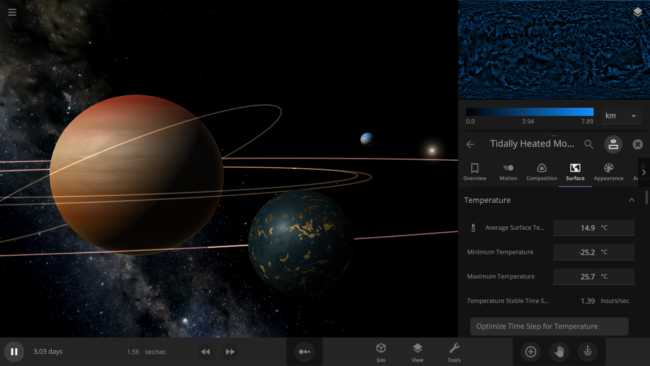
A tidally heated habitable moon located outside of the habitable zone. The warmer surface temperature, due to tidal heating, allows liquid water to flow on this moon.
Try creating your own tidal heating simulations, and experiment with the masses and orbits of objects (especially the orbital eccentricity) to see how these properties affect the amount of tidal power added to an object. Can you make a habitable moon or planet outside the habitable zone?
Note: You may have noticed the odd looking spike in the “Jupiter’s moon Io orbiting the gas giant” graph. One of the challenges that comes with simulating complex features like tidal heating in Universe Sandbox is that when you increase the speed of the simulation, accuracy in the calculations can decrease. These abnormalities occur because there are less points of data to reference. The graph could be smoothed out by estimating data points in between, but that would introduce inaccurate data, and we’re all about accuracy here.
This blog post is part of our ongoing series of ScienceLog articles, intended to share the science behind some of Universe Sandbox’s most interesting features. If you would love to learn about the real-life science powering our simulator, please stay tuned and let us know what you would like to read about next.
To join our community discussions, please join us on our Steam Forum and our official Discord community.

Energy and Heating | ScienceLog #1
Jul 23rd
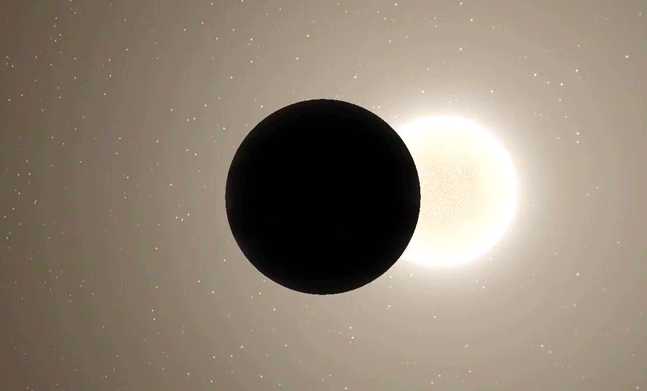
Jupiter orbiting a mere 0.04 AU from the Sun, heating quickly under the intense stellar energy it receives at this distance.
It’s Getting Hot in Here…
One of the many important astrophysical processes that Universe Sandbox simulates is the changing temperature of an object as it is warmed by nearby stars and other sources of heat. Thanks to our new Surface Grids feature, introduced in Update 24, Universe Sandbox can now simulate the heating of each point on an object’s surface, to create a 2D map of a planet or moon’s surface temperature.
In addition to the Surface Grids simulation in Update 24, we also added new properties and tools related to heat and temperature in Update 25, so we wanted to take this opportunity to explain what makes planets get so hot (or cold!), and how you can use Universe Sandbox to explore the flow of energy through your objects.
Go with the Flow: Energy Flow and Temperature
So what makes the temperature of an object change? It all comes down to energy. An object like a planet or moon is continuously absorbing energy from its surroundings (like the heat from nearby stars) and radiating energy out into space. If the object is absorbing more energy than it is radiating away, that extra energy is used to raise the temperature of the object. On the other hand, if the object is radiating more energy than it’s receiving, that lost energy causes the object’s temperature to drop.
Universe Sandbox simulates the temperature of an object based on the flow of energy into and out of the object. You can see the data related to this “Energy Flow” in the Surface tab in the object’s properties panel. The first two properties, Energy Absorption Rate and Energy Radiation Rate, show the speed at which the object is gaining and losing energy. The Heating Rate tells you how fast the object’s surface temperature is expected to change based on this energy flow. If the object is absorbing more energy than it’s radiating, the Heating Rate will be positive, and the object will heat up. If it’s radiating more energy than it’s absorbing, the Heating rate will be negative, and the object will cool down.
Try experimenting with properties like the object’s Average Albedo or Surface Heat Capacity to see how they affect the energy flow rates and surface temperature (or check out our Energy Flow guide in Home > Guides > Tutorials > 14 – Energy and Heating).
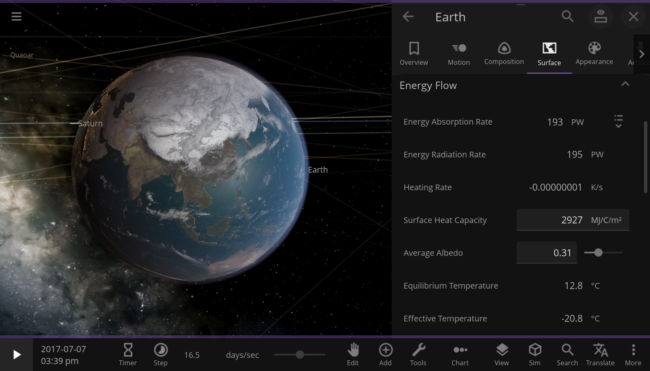
The Earth in the Solar System, with the Energy Flow section displayed in its properties panel.
Heat Wave: Sources of Heat Energy
What are these sources of energy that can heat an object in Universe Sandbox? Energy from stars is the major source of heat in most simulations. These heat sources are directional: they only heat the part of the object’s surface facing the star. Heating from supernova explosions is also directional, not to mention extremely powerful.
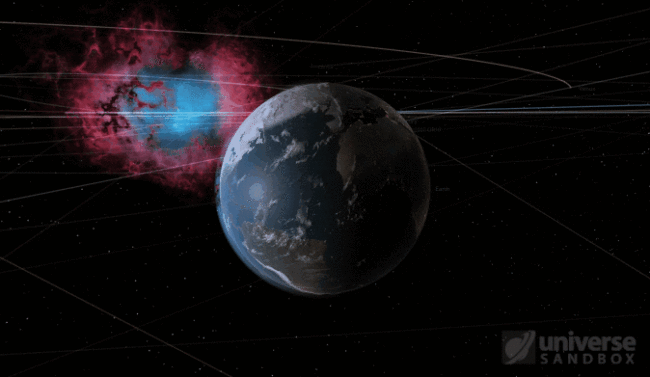
The Earth, heated by a recently exploded Sun. The directional heating from the supernova causes the side of the Earth facing the supernova to receive all the heat energy. Eventually, the Earth absorbs too much energy, too fast, and it is vaporized away.
Other sources of heat come from all directions at once, or from inside the object, so the heat energy is evenly distributed over the object’s surface. For example, objects with atmospheres are heated by energy that the atmosphere radiates back down towards the surface. (This is the mechanism that causes the greenhouse effect leading to the climate crisis here on real-life Earth.)
All these contributions to the heating of an object are listed in the Energy Flow section, and can be seen by expanding the Energy Absorption Rate property (by selecting the list icon on the right side of the property).
Temperature Simulation in Two Dimensions
The properties in the Energy Flow section are used to estimate the change in the object’s Average Surface Temperature, a single value that represents the temperature of the object as a whole. The Surface Grids feature also allows us to simulate this energy flow and heating process at every point on an object’s surface. You can see the object’s 2D temperature map at the top of the Surface tab. Hovering over a pixel on the map will display the temperature at that point.
This temperature map is especially useful for seeing the effects of directional heating. For example, selecting Tidally Lock in an object’s Motion tab will change the object’s rotation period such that one side of the object always faces its star and the other always faces away from the star. If we tidally lock the Earth, the hemisphere facing away from the Sun will get so cold that the ocean freezes over, while the side facing the Sun gets uncomfortably warm. Even though the Earth as a whole is receiving the same amount of energy from the Sun, the conditions on the surface, simulated by Surface Grids, have changed a lot!
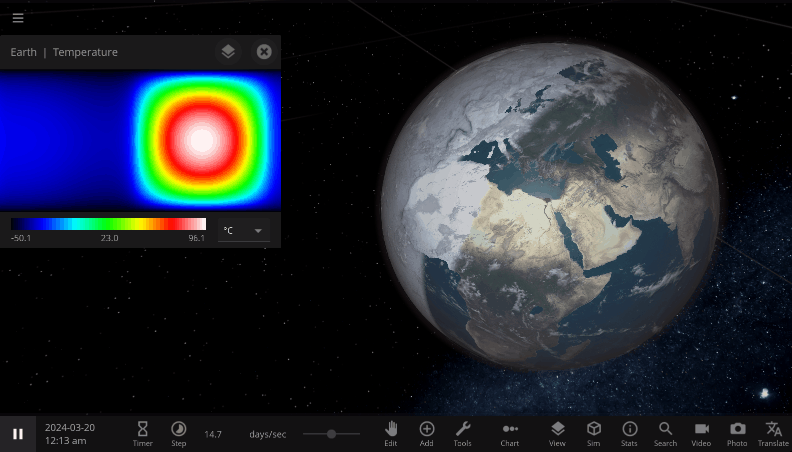
A tidally-locked Earth, spinning so slowly that one side always faces the Sun and the other always faces away. The “night” side gets so cold that it freezes over, while the “day” side continues to heat in the constant, direct sunlight.
This blog post is the first in our new series of ScienceLog articles, intended to share the science behind some of Universe Sandbox’s most interesting features. If you would love to learn about the real-life science powering our simulator, please stay tuned and let us know what you would like to read about next.
To join our community discussions, please join us on our Steam Forum and our official Discord community.

Even More Color in Space | Update 25.2
Jul 2nd
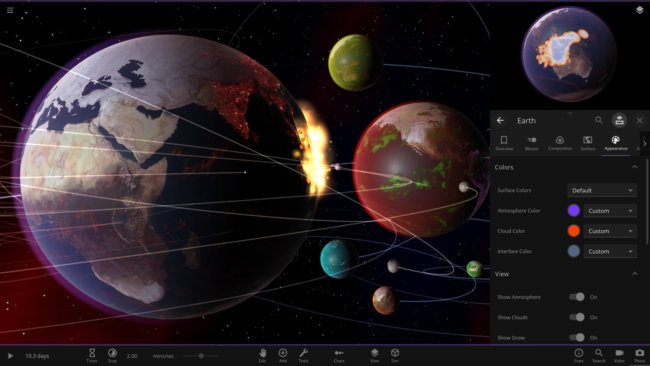
Run Steam to download Update 25.2, or buy Universe Sandbox via our website or the Steam Store, where it’s 33% off until July 9th, 2020.
Update 25.2
Update 25.2 is a minor update that brings even more appearance options, this time to clouds, galaxies, and asteroids. We’ve also improved energy transfer calculations, laser settings, asteroid visuals, and provided various other bug fixes.
Most of the team has been hard at work on our upcoming major updates, but we didn’t want you to wait for these features and bug fixes. Keep an eye out for Update 26 (Coming Soon™) which will bring major improvements to our user interface and VR implementation.
Cloudy with a Chance of Purple
Change the color of clouds, galaxies, city lights, and asteroids. Toggle snow visuals on or off to help distinguish snow from sea ice.
Asteroid Makeover
Asteroids received a complete visual overhaul and color correction.
Improved Energy Simulation
Energy Flow calculations now including lasers, explosions, and impacts. Learn more about Energy Flow from Home > Guides > Science > Energy and Heating in Depth.
Featured Fixes
- Simulations with broken surface data can now be opened
- City Lights no longer appearing incorrectly on some rocky objects
- Black hole radius can now be manually changed as expected
Please report any issues on our Steam forum, on Discord, or in-game via Home > Send Feedback.
Hiring a Community Manager & Administrative Assistant
May 29th
This position has been filled. Thank you to everyone who applied.
If this still sounds like an ideal job for you, please reach out. We are always looking for more help from the right candidates.
Giant Army is looking for a Community Manager & Administrative Assistant to help with our continued work on Universe Sandbox, a space and gravity simulator with a 93% positive rating on Steam.
As a representative of Universe Sandbox, you will engage with the community in various channels and respond to comments, feedback, and issues. You will also post on social media, create blog posts, and handle support as well as general emails. You will be expected to maintain familiarity with Universe Sandbox and help with other community, administrative, and non-development tasks as they come up.
This is an hourly position with a potential of 25 to 40 hours per week.
Join us. We’re making something incredible that’s unlike anything else.
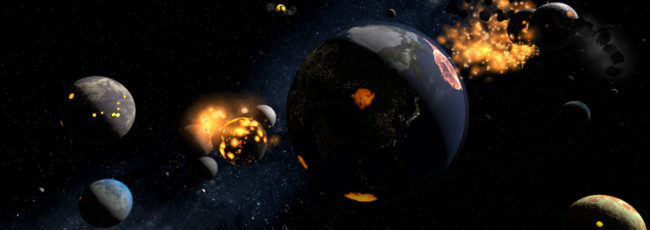
Your Role
- Communicate thoughtfully with community, customers, business partners, media, etc. as a representative of Universe Sandbox
- Manage community and social media
- Engage with fans (and potential fans) of Universe Sandbox on forums, Discord, social media, etc.
- Craft messages and post on social media (Facebook and Twitter)
- Act as a liaison between the community and Universe Sandbox team
- Respond to comments, feedback, and issues, and synthesize for team
- Create and maintain text/documents like blog posts, website content, and release notes
- Provide customer support and respond to emails
- Maintain familiarity with the Universe Sandbox experience
- Help with other administrative/non-development tasks as they come up
Qualifications
- Enjoys and is skilled in writing
- Organized and self-motivated; comfortable working collaboratively and remotely
- Strong verbal and interpersonal communication skills
- Experience with customer support
- Understanding of online communities, social media, and marketing
- Personable and energized by working with a wide variety of personalities
- Experience with G Suite (Gmail, Google Calendar, Docs, Spreadsheets, etc.)
- Core availability Monday-Friday from 11am-3pm PST to interact with the team
- Enjoys video games; experience with Steam
- Passion for science, astronomy, and education (and Oxford commas)
- Familiarity with game or software development is a plus
Company Overview
Giant Army is the company behind Universe Sandbox. Our headquarters are in Seattle, Washington, USA, with team members across the United States, Germany, Denmark, and Australia.
Team members enjoy a flexible, collaborative environment that values work-life balance. We pursue the features that get us excited about science, and we do the work so we can share it with others. We strive to create an accessible experience that can’t be found elsewhere.
We believe science and video games are for everyone, regardless of identity, and we’re committed to making an inclusive workplace. We encourage anyone who shares our passion for space to apply.
Product Overview
Universe Sandbox is a powerful space simulator that lets you create and destroy on an unimaginable scale. Experiment with gravity, climate, and collisions to reveal the beauty of our universe and the fragility of our planet. It’s more than a game; it’s a way of experiencing and learning about reality in a way that’s never been done before.
Universe Sandbox is available on Windows, Mac, Linux, and VR with mobile and future platforms planned. We’ve sold over half a million copies and have a “Very Positive” rating on Steam with 93% positive user reviews.
How to Apply
This position has been filled. Thank you to everyone who applied.
If this still sounds like an ideal job for you, please reach out. We are always looking for more help from the right candidates.

Universe Sandbox Roadmap: 2020 & Beyond
Apr 30th

Universe Sandbox has improved significantly since our first Early Access release in 2015. We plan to add features and fix bugs for a long, long time to come (we even removed the “2” from our name for that reason). Here’s a look into what we have planned for 2020 and beyond.
What did we do in 2019?
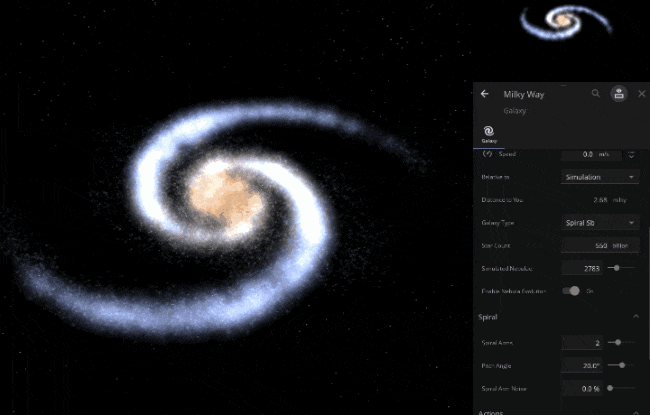
Last year saw 3 major feature releases (and a handful of minor, but still important, updates):
- Better Galaxies (Update 23)
- More stable and accurate galaxies and better collisions
- New and improved Introduction tutorial for helping new users
- Surface Grids & Lasers (Update 24)
- Surface Grids is a huge, complex feature that simulates the surfaces of planets, moons, and other objects
- Vaporize entire planets with the new Laser tool
- Custom Object Colors (Update 24.1)
- Customize colors for just about every object including planets, moons, stars, and black holes
- Dock graph windows alongside the other panels added with Surface Grids
View our “What’s New” for a chronological list of changes.
What’s the Plan for 2020?
The following list are all things we are working on currently. We’re aiming to deliver on all of this in 2020, but when they’ll be ready is difficult to predict, and priorities can change.
With its ability to simulate localized surface temperatures, water level, vapor content, and more, Surface Grids (Update 24) perfectly sets us up for a multitude of new features. Localized temperatures enabled us to create the mighty Galactic Empire Superlaser, but that’s only scratching the surface…
Surface Grids Improvements
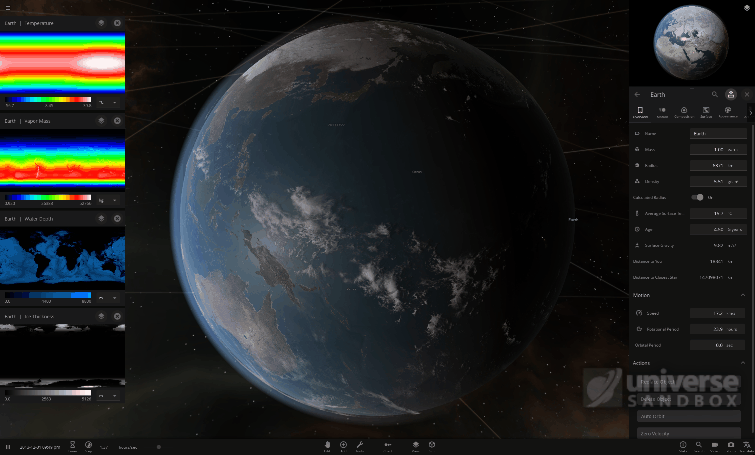
We’ve been saying that Surface Grids is the foundation for many things to come, so it only makes sense that we start the year off by further improving it.
- Improved Temperature & Atmosphere Simulation
- Surface Grids improvements started this year in January (Update 24.1.2), continued with Update 25 (March 2020), and will be a theme all year long
- Update 25 introduced a major rewrite to Tidal Heating and Vapor Flow calculations
- Better Performance & More Power
- Not only have we accomplished localized surface simulations on your everyday computer, but we continue to make performance improvements
- Shader Model 5.0, a graphics card technology, became a requirement in Update 25 because it will give us some legroom for current and future enhancements
- Detailed Surface Manipulation
- We are in the early stages of designing tools that allow for directly manipulating temperature, elevation, water level, vapor, and more on the surfaces of objects
- We plan to add the ability to view and edit the properties of individual surface grid “cells”. Take your planet customization and terraforming to a new heights with a level of precision you never thought possible
Material Composition System
Building off of the localized materials (water, CO2) in Surface Grids, we’re working to rebuild our material composition in a more robust way.
- Better System to Unify Materials
- Every point on the “grid” will better contain a mixture of various materials, in various material states
- Complicated calculations of, for example, when some liquids become heated to a gas, should be handled more efficiently in our new simulation code
- A Universe of Possibility
- Better terraforming, more realistic cloud and climate simulations, tidal waves, easy ways to manipulate the surface topography, and more detail on the surface view could all be the results of this new Material Composition System
- Who knows, maybe our planets could one-day support life?
Full Desktop User Experience in VR
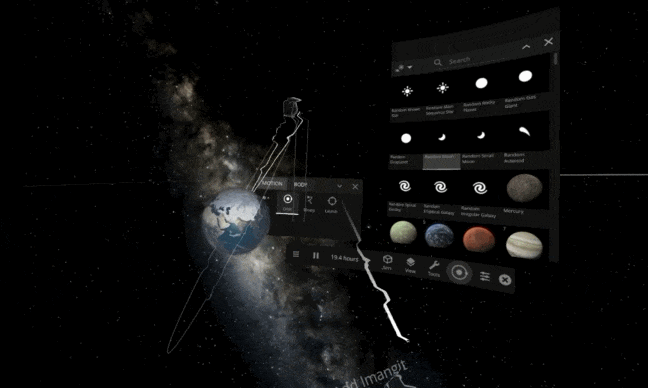
We have embraced a seemingly impossible goal of having a unified Universe Sandbox release no matter how you play. Whether you are on a powerful gaming PC, a laptop, a phone (coming soon), Virtual Reality, Mixed Reality, or a console (maybe soon? who knows!) the experience should be undiluted and awe-inspiring.
- A Magic Leap Forward
- With our recent Magic Leap 1 release, we were able to bring the full Desktop experience to the world of Mixed Reality
- Hard work pays off: the bulk of our Magic Leap 1 development helped unify our Mixed Reality, VR, and Desktop experience into one single vision
- Get Your Hands on it
- Enjoy Universe Sandbox in VR without limitations and with the full Desktop User Interface
- Grab planets with your hands, shoot lasers out of your fingertips, and watch galaxies collide as if you were really there, floating in space (but a bit less cold).
User Interface Improvements
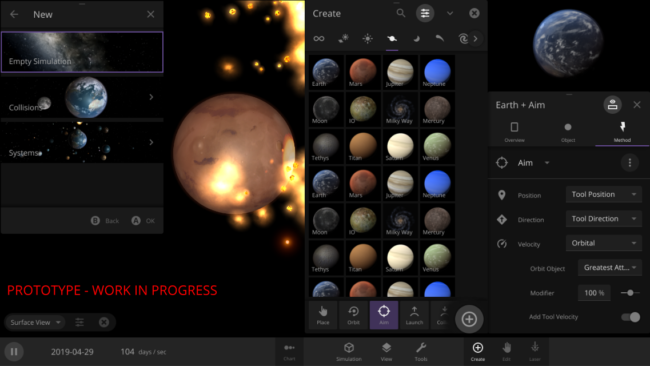
Creating the user interface (UI) for Universe Sandbox is a fun challenge. How do you give someone full control of the universe? As we add features and complexity to the simulation, keeping the UI accessible, discoverable, and easy to use becomes a constant challenge.
Over time, some portions of the interface can start to feel cluttered or outdated and are ready for a redesign. We’ve been working on some of these design changes for a long time, and it’s exciting to move closer to improving everyone’s experience with Universe Sandbox.
- Redesigned Bottom Bar
- Our current bottom bar has been collecting new buttons over the years without a cohesive vision for how it should all work. So we’ve rethought how everything should be organized and how we can make it work on really small screens.
- Improved Add Panel
- Like the Bottom Bar, the Add Panel is due for a makeover. We’re targeting a single shared UI for all platforms (desktop, touch, VR/AR, and consoles), so the new Add Panel is being built with that in mind.
…and beyond?
Mobile
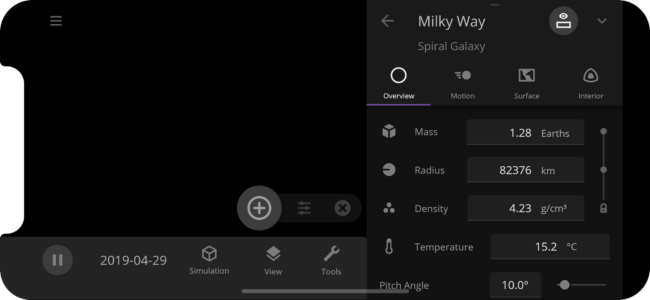
Enjoy Universe Sandbox on your phone or tablet! Sign up to get notified about our mobile version.
- Is that Universe Sandbox in Your Pocket?
- Our mobile version is in development right now for both Android and iOS. It’s no easy feat to simulate the universe on a smartphone, but we’re doing it!
- A Pure, Unadulterated Experience
- Some of the breakthroughs we made with both Surface Grids and Magic Leap have paid off and will allow for the full desktop version on your pocket-sized device
Life Simulation
Create the right conditions for life and watch it grow, or end it all with a major impact.
- Turn a cold, lifeless space rock into a vibrant planet
- Many details are still TBD, keep an eye out for a DevLog when we get started
Fluid Simulation

Smoothed-particle Hydrodynamics (SPH) will help create more detailed, realistic simulations of collisions, fragmentation, and formation of different types of objects. Read more in our SPH Fluid Simulation DevLog.
Experiments with Tools

This is firmly in the realm of experimentation at the moment, but we’re looking at new and interesting ways we can use our tools within a simulation. Driven by a need to automate testing of features, we’re working on ways to programmatically activate tools. By automating and attaching different tools to objects, we discovered that we can enable some pretty fun scenarios. The above clip is what happens when we attached a bunch of lasers to moons and tell it to automatically fire at the nearest object. Awesome stuff, right?
Gamepad Support… and more?
Do you want to sit back on your couch and play Universe Sandbox? So do we! We’ll be experimenting with full gamepad support. Who knows where that leads us, maybe even a console version in the future.
Hiring
We are currently hiring a Spaceship Physics Developer, join us!

Light It Up | Update 25.1
Apr 20th
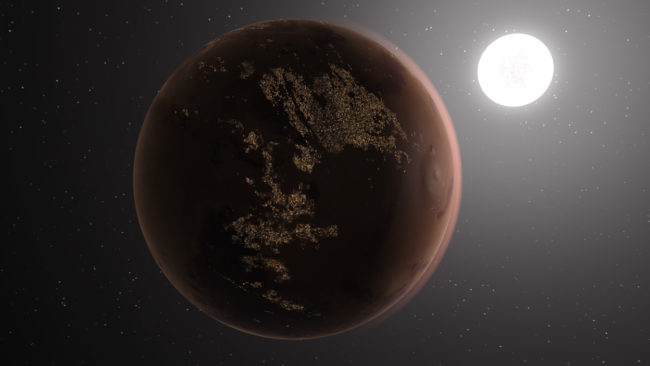
Run Steam to download Update 25, or buy Universe Sandbox via our website or the Steam Store.
Update 25.1 includes a host of bug fixes and lighting improvements, as well as a fun oft-requested feature to add customizable city lights to any rocky planet or large moon.
City Lights on Any Planet
You can now enable City Lights on any rocky planet or large moon by going to Object Properties > Appearance > City Lights. Select from Earth’s city map or a randomized procedural map, and define whether the lights will turn off if the surface is deemed uninhabitable.
Lighting Improvements
The interaction of multiple light sources has been reworked, particularly with how they reflect off an atmosphere.
General Fixes
We fixed a bunch of miscellaneous issues, including improving how supernova clouds impact objects, star temperature instability, orbit previews, shadows, and more.
Please report any issues on our forum, on Discord, or in-game via Home > Send Feedback.
I Like My Heat Tidal | Update 25
Mar 13th

Run Steam to download Update 25, or buy Universe Sandbox via our website or the Steam Store.
Update 25 brings significant improvements to our temperature and surface simulation, adding stability and accuracy, drastically improving speed, new object properties, and a rewrite to our tidal heating model. We’ve also added some often-requested features such as “Replace Object” and graph data export, as well as relocating save data associated with removing the “²” from “Universe Sandbox”.
Major Surface Simulation Performance Improvements
Moving from Shader Model 3 to 5, a feature of most modern graphics cards, allowed us to utilize new technology (compute shaders), lowering the video memory requirements of the surface simulation by almost half and increasing performance substantially. Moving forward, this will allow us to add additional complexity to surface grids, better collisions (using smoothed-particle hydrodynamics), and gorgeous graphical features. Because of this change, we have updated our minimum system requirements.
Temperature & Atmosphere Rewrite
Tidal heating and temperature calculations have just received a major rewrite. This includes significant improvements to vapor flow, atmosphere energy retention, and overall object energy absorption and radiation. You can see these properties in action in the new Energy Flow section in an object’s Surface tab, and in our new Energy and Heating guides.
Hot-swappable Celestial Object
A “Replace Object” button has been added to the Properties panel. This will allow you to hot-swap any object in the simulation for any other object, enabling a bunch of fun scenarios that were hard to do in the past.
The “²” is Silent
Just call us “Universe Sandbox”, we’ve gotten rid of the “²”. When loading the update for the first time, you may notice a “Migrating Data” message. We’re automatically reorganizing settings and saved files to reflect the name change.

Check out the full list of What’s New in Update 25
Universe Sandbox 2019 Retrospective
Feb 25th

While there’s a lot to look forward to in 2020, we’re going to take a moment to celebrate the milestones we reached this past year.
1
New team member.
Brendan is a graphics developer from Australia and is joining Georg in making everything in the universe beautiful, awesome, and graphically performant. He’s already worked on improving random planet generation, fixing black hole issues on the Magic Leap, and is now creating visuals for our experimental liquid planets project, AKA smoothed-particle hydrodynamics (SPH).
2
Number of full-time developers on a new platform.
Magic Leap 1! We started a new journey into augmented reality in 2019 and we’re really proud of the work we’ve done to bring the full power of Universe Sandbox to Magic Leap as an undiluted experience. Dave and Jacob focused most of the year on Magic Leap with support from the rest of the team.
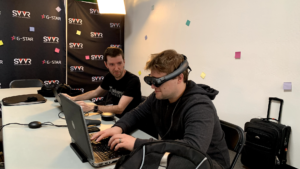
Universe Sandbox creator & director, Dan Dixon, working on Magic Leap with developer Dave Nelson.
4
New human-sized objects.
- banana
- watermelon
- sword
- sledgehammer
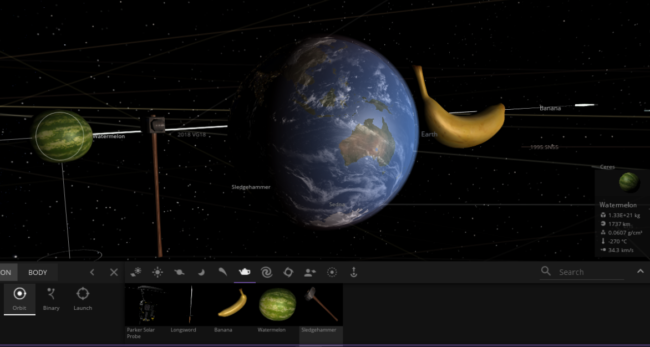
Everything you need to make a very bad fruit salad.
7
Significant updates to Universe Sandbox.
- Revamped Vapor & Engine Experiments | Update 22.2 | April 10, 2019
- A Big Day for Physics | Update 22.3 | May 30, 2019
- Beyond the Milky Way | Update 23 | June 25, 2019
- Galactic Clean-Up | Update 23.1 | August 20, 2019
- Saturn’s New Moons | Update 23.2 | November 01, 2019
- Surface Grids & Lasers | Update 24 | November 22, 2019
- The Color in Space | Update 24.1 | December 19, 2019
This year had a mix of improving existing content and rolling out new features. While there were fewer objects added, several key systems got revamped (see Surface Grids), setting the team up for exciting additions in the coming year.
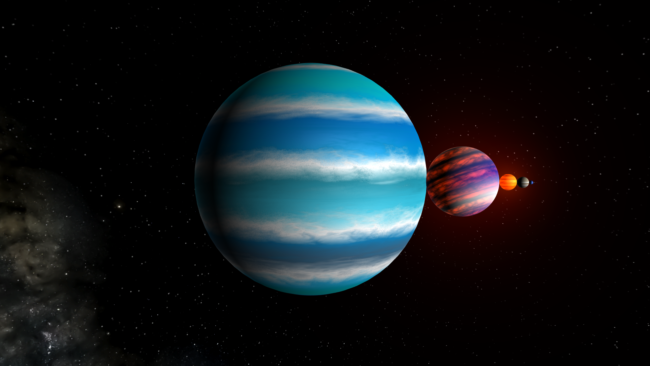
Image provided by Discord user Mangolia.
28
# of languages we now support, up from 22 last year.
A big thanks to our community for helping with our crowdsourced translation efforts! Want to help translate Universe Sandbox into your native language? Learn more.
| Bulgarian | Chinese Simplified | Chinese Traditional | Czech | Danish |
| Dutch | English | Filipino | Finnish | French |
| German | Greek | Hungarian | Indonesian | Italian |
| Japanese | Korean | Norwegian | Polish | Portuguese |
| Romanian | Russian | Spanish | Swedish | Thai |
| Turkish | Ukrainian | Vietnamese |
601
Highest number of concurrent users in Universe Sandbox in 2019.
This is higher than in 2018, and second only to our all-time high of 617 players in March of 2016, during our first big Steam sale.
1,963
# of users in our Discord server.
2,124
# of positive Steam reviews in 2019.
Seeing so much love for Universe Sandbox warms our hearts the way gravitational squishing heats Io.
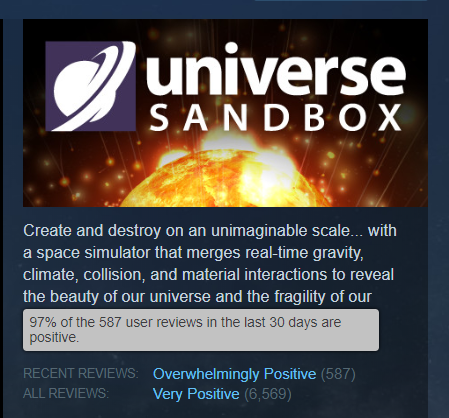
Overwhelmingly Positive reviews. Wow!
2403
# of code commits (changes) made to the Universe Sandbox project in 2019.

A look at our GitHub commits activity since 2015. The gray section shows 2019.
14,893
# of shared items in the Universe Sandbox Steam Workshop.
This is over six times as many as 2018! We can’t wait to see how this library of community creations grows in the coming year! To get through all of them in 2020, you’d have to check out slightly more than 40 per day. (Get cracking?)
103,541
# of messages sent on Slack (an instant messaging platform we use to communicate).
Giant Army is a completely remote team, with some dozen members on three continents. We also use Google Meet for our face to face video meetings but much of our work happens in text.
163,298
# of units sold on Steam.
In 2018, we sold a copy just about every five minutes. In 2019, that interval narrowed to a little under 3 minutes and 15 seconds.
474,811
Lasers equipped since our Surface Grids & Lasers release.
This is one of the stats we track using our built-in analytics.


The magic cold laser in action. Image provided by Discord user Anonymoose/BlueMarble.
8,093,789
# of views on most viewed Universe Sandbox video of the year.
We’ve been delighted to see GreyStillPlays make 26 videos featuring antics in Universe Sandbox.
10,485,760
# of individual data points we are simultaneously simulating on object surfaces.
This is our Surface Grid system, which is a foundation that we’ve been working on for years, and will enable us to skyrocket into the future with some pretty exciting features. More on that soon in the 2020 roadmap.
(with atlas resolution of 1024 × 2048 × 5 layers = 10,485,760 | higher-end computers can simulate 2048× 4096 × 5 layers = 41,943,040 points).
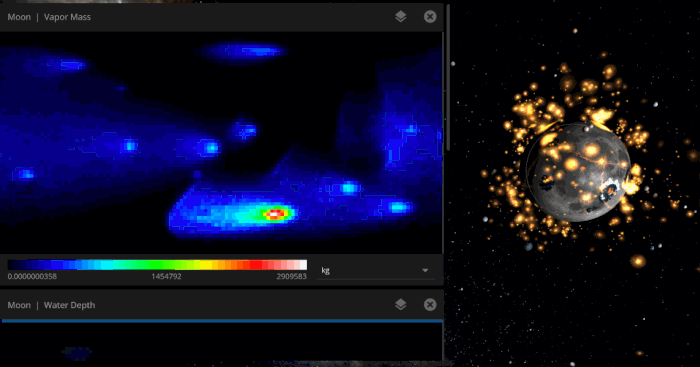
Vapor content on the Moon as it is bombarded by icy asteroids
What’s next?
Improvements to heat and material simulation across object surfaces, new tools, life simulation, better performance, data analysis, Magic Leap, a completely revamped VR experience, SPH – it’s hard to list it all. The foundational work we did in 2019 sets us up to do amazing things in the coming year.
Stay tuned for a 2020 roadmap, which we’ll publish next.
Thank you to everyone, to both new players and those who have been playing Universe Sandbox for years. Whether you’re analyzing orbits, creating fictional worlds, learning about astronomical material properties, or just having fun throwing planets together, we truly couldn’t do this without your continued enthusiasm for our little astronomy simulation. And we’re just getting started.
The Universe Sandbox Team
Dan, Chris, Georg, Alexander, Jonathan, Dave, Rappo, Mat, Jacob, Erika, and Brendan
The Color in Space | Update 24.1
Dec 19th

December 20: Update 24.1.1 is a small patch that fixes a handful of bugs, including issues with gas giant band order and lighting for custom star colors.
Run Steam to download Update 24.1, or buy Universe Sandbox on Steam where it is 33% off until January 2, 2020.
Customize Those Colors
Customize colors for just about every object in the new Appearance tab. Add dozens of bands to gas giants, turn Earth’s atmosphere red, or color your alien star purple. We aim for realism in Universe Sandbox, but that doesn’t mean we can’t also allow for creativity.
Dock Those Graphs
Graphs are now docked alongside the other view panels added with Surface Grids, making it easy to keep your eye on data for different objects and properties as graphs, maps, and surface views.
Launch That …Sword?
We added a sword. Don’t think about this one too much. Add > Objects > Longsword
This update also improves black hole visuals, makes it possible to view Surface Grids data directly on an object’s surface, and adds a bunch of smaller improvements and bug fixes.
The name of this update is an homage to the H.P. Lovecraft sci-fi short story The Color Out of Space. A film adaptation of the same name, starring Nicolas Cage and coming to theaters in January 2020, features a scene with a character playing Universe Sandbox. Catch a glimpse of it in the trailer at the 0:17 mark!
Check out a full list of What’s New in Update 24.1
Happy holidays!
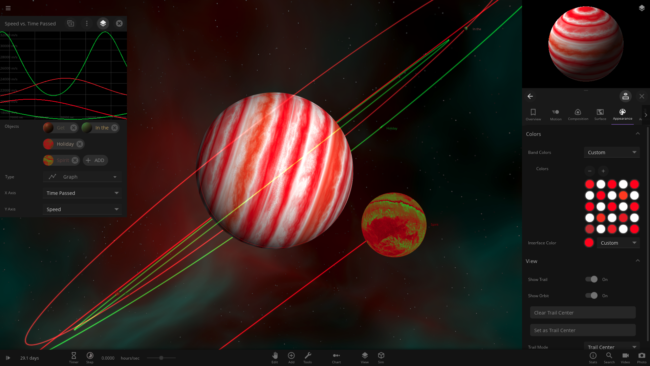
SPH Fluid Simulation | DevLog
Dec 13th

Video: Simulating a planetary collision using a new method called smoothed-particle hydrodynamics (SPH).
Hopefully by now you’ve had time to check out Surface Grids & Lasers | Update 24 of Universe Sandbox. If you haven’t, time to get out from that rock you’ve been living under and start terraforming all those other rocks floating through space.
We plan to continue to add to the Surface Grids feature with even more detailed surface simulation through next year and beyond. Surface Grids is a massive new feature that changes a lot with the core simulation of objects in Universe Sandbox, and so far we’ve just scratched the surface of what it can do. We’re excited to explore its possibilities even more.
But right now, let’s turn our attention to something our physics developer, Alexander, has been working on. Introducing… smoothed-particle hydrodynamic fluid simulation. Let’s just call it SPH for now.
SPH is NOT included in Universe Sandbox yet. This is a behind-the-scenes look at a feature that we are still working on.
What is SPH and how does it work?
For a deep dive into the mechanics of SPH, check out this paper from our very own physics developer, written back in 2010 (interestingly, not written in relation to Universe Sandbox, but for another project that was similar in many ways — there’s a reason why we hired him many years ago to help build this new version of Universe Sandbox, and it had more to do with relevant experience than it did with his propensity for typos… *wink*).
Or if you’re curious about SPH, but perhaps not curious enough to read 35 pages on it, here’s a crash course:
SPH is a computational method commonly used for modeling fluids (though it can also handle solids). That might make you think that we’d use this for simulating something like water flow on a planet’s surface, but “fluid” here actually has more to do with simulating much larger objects.
On an astronomical scale, many of the objects you can simulate, like stars and galaxies, behave like fluids. This is also true for planets, whether it’s a gas giant or a rocky planet with, or even without, a molten core. And even in the case of large chunks of solid rock colliding with each other, there is such intense temperature and pressure that the materials behave more like fluid rather than rigid solids: they’ll stretch and distort and be torn apart, rather than splinter, crack, and shatter.
So in short, SPH will help create more detailed, realistic simulations of collisions, fragmentation, and formation of different types of objects in Universe Sandbox.
How? First, the material, such as a planet, is broken into a number of “particles” that each have properties such as mass, temperature, velocity, and position. You can see these particles clearly in any of the videos in this post.
But the “smoothed” part of “smoothed-particle hydrodynamics” means that these particles are just sample points of what is actually a continuous material, where they each contribute to the properties at a given point based on a weighted, smoothed, average. Together, they describe the properties that exist at any given point in a flow of material, but they themselves are not the material. Think of it like buoys in an ocean: the buoys will each monitor the properties at their location, and they are distinct from the continuous fluid, ie the ocean, that they are monitoring. So for the future of SPH in Universe Sandbox, the current debugging visuals, where you can see individual particles, will ideally be replaced by something that better represents the continuous fluid that is actually being modeled.
By tracking how each of these particles move, and more importantly how they move in relation to their neighbors, you can calculate pressure and viscosity (friction) at any point in
the fluid. And then you can estimate how this will move over time under different forces. Combine this with gravity and you start to see a simulation with emergent behavior that matches what we observe in real life.
Why SPH?
Because you get accurate simulation with emergent behavior, rather than disparate modeling of phenomena that needs to be stitched together. For example, with SPH, material will collect under the influence of gravity, but it will not all fall to the center of mass. Instead, as more material collects, the pressure increases and starts pushing out material, preventing a total collapse. The result is a spherical shape, and not because we specifically told it to become a sphere, but because that’s what happens when you simulate physics on a more granular level.
Or look at the case of Roche fragmentation, where a moon may be torn apart from the gravity of its host object “pulling” more on its near side than its far side. In our current simulation, pre-SPH, where we model how single points of mass move purely under the influence of gravity, we need special handling to calculate when and how this should happen, according to analytical models. But with SPH, this phenomenon just happens as the result of forces acting on the moon.
Why SPH specifically and not another method? When simulating space, there is more literal space than there is simulated material. SPH is great for handling cases like this where material is sparse. Other methods instead require simulating each point of space, seeing how each of these points changes (versus tracking only points specifically in a material), which would be very slow for anything like entire star systems.
Universe Sandbox is a unique physics simulator because we aim to make it an accessible, real-time, interactive experience. When compared to non-real-time simulations run on supercomputers, this presents a lot of limitations, and SPH is not immune to these. The biggest issue we will need to navigate as we continue development is the resolution of the model — to be really accurate and demonstrate smaller, local changes, you need a lot of sample points. But each point comes at the cost of a good chunk of computing power. So as with all features in Universe Sandbox, we’ll need to find a balance, with enough points to model things in interesting ways, but not so many that it becomes a slideshow.
So… what does it do?
Technical explanations are fun (…did I get that right?), but what you really want to know is what does this SPH thing mean for me and my planets? That’s also answered above: it will help create more detailed, realistic simulations of collisions, fragmentation, and formation of different types of objects in Universe Sandbox. But what you really, really want is a bunch of videos of this is in action. Understandable.
Quick disclaimer: SPH is a feature in its early stages of development. Visuals are for debugging purposes. Anything shown many not be representative of how it’ll appear and behave when included in an official Universe Sandbox update.

Two equal-sized bodies showing pulsating behavior as pressure and gravity tries to find a balance.

Two earths spinning the same direction and colliding. The result is a combined body with non-zero angular momentum from the individual momentums adding together in the same direction.

Increasing the density and speed of Mars before it impacts Earth and shoots right through it.

The existing simulation “Earth & Moon x25 Offset” showing all Earths collapsing and combining.
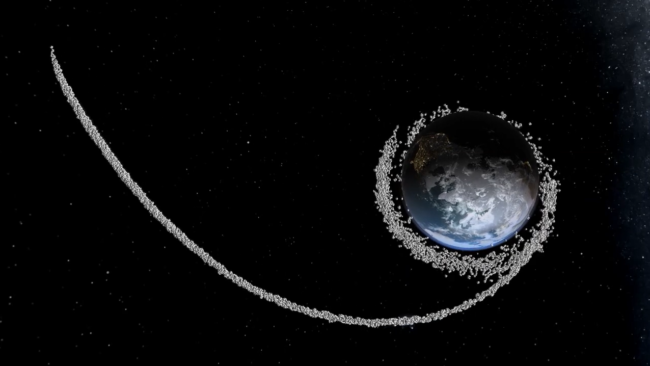
Results of the Moon fragmenting around Earth.
So in short, SPH will improve or make possible simulations of the following:
- Total fragmentation
- Tidal deformation and Roche fragmentation
- Accretion disks / object formation from debris
- Giant-impact hypothesis (moon formation!)
And in the longer term, we hope to apply it elsewhere, including more accurate galaxy collisions and star formation.
What’s Next
As you can see, SPH is already working pretty well within Universe Sandbox. But you can also see that it’s not exactly integrated with everything else yet. The visuals right now are intended solely for debugging purposes, and the transition from our standard planet visuals to the SPH particles is a little rough. Making visuals that look more like molten planets being torn apart will definitely take time, but we have some ideas in mind that we’re excited to explore.
The visuals are just one component of what we’ll need to work on to integrate SPH with Universe Sandbox. Making it work with other complex aspects of the simulation, like the new Surface Grids feature, will be its own can of worms. But we’re no strangers to technical challenges. And since we think SPH is worth experimenting with on its own, we hope to release an early version of it using the debug visuals and let you turn it on if you’re interested in checking it out. We don’t know when this will happen yet, but hopefully not too long into next year.
And hopefully before then, we’ll have a small update ready that will add some oft-requested color customization…
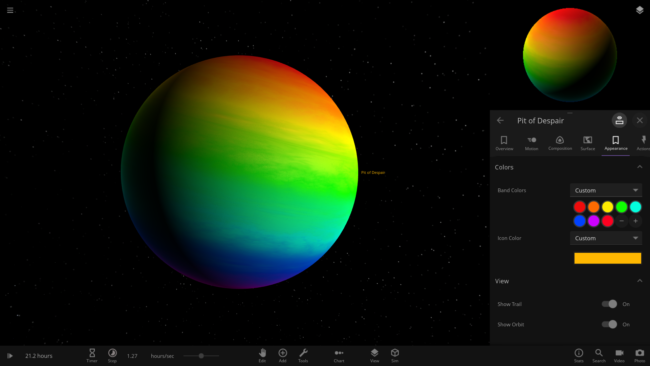
Last Updated: November 14, 2022

